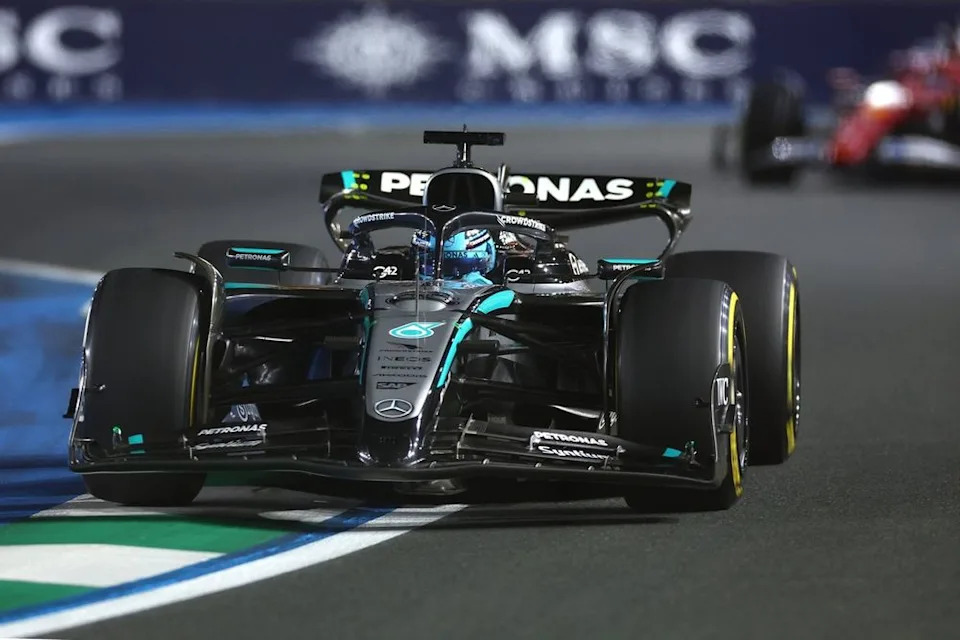Forward of the Saudi Arabian Grand Prix, one of many recurring themes of the weekend was graining. Graining occurs when the tyres are pressured earlier than reaching their optimum working window, or when ambient temperatures are too low to permit the tyres to work accurately.
Besides at , the precise reverse was occurring: no graining, however relatively, blistering. It was an anomaly, hardly ever mentioned since racing began in Saudi Arabia, as a result of the wonderful asphalt in Jeddah has all the time offered a whole lot of grip, pushing the main focus towards the graining challenge.
Commercial
Mercedes was actually ŌĆ£cookingŌĆØ its tyres whereas struggling to handle the thermal degradation. It wasnŌĆÖt simply accelerated put on, however relatively poor temperature administration ŌĆö the identical challenge that plagued┬Ā throughout Friday’s lengthy runs.
George Russell, Mercedes
George Russell, MercedesPeter Fox – Getty Pictures
Peter Fox – Getty Pictures
Trying again, throughout each apply and qualifying, it was noticeable that permitting the tyres to chill helped recuperate efficiency ŌĆö even with the mushy tires, the place it was attainable to aim two or extra laps with out a important drop in tyre efficiency.
Throughout the race, nevertheless, there was no alternative to decelerate and let the tyres breathe, inflicting the temperature to rise uncontrollably and triggering a series response that lowered grip, elevated sliding, and, in flip, additional overheated the tires. Whereas managed the state of affairs completely, even pushing on the finish of the primary stint and stunning their rivals, Mercedes cooked its tyres.
Commercial
It made for an surprising state of affairs, particularly contemplating that within the early season races, the W16 had proven it might handle tyre temperatures properly, akin to in Bahrain, the place the group accomplished the ultimate stint on mushy tyres ŌĆö a method Ferrari even did not contemplate possible.
George Russell, Mercedes
George Russell, MercedesZak Mauger / Motorsport Pictures
Zak Mauger / Motorsport Pictures
ItŌĆÖs not a coincidence that Mercedes recognized Sakhir as a check monitor to judge if the group had overcome the tyre temperature administration points found final yr with the W15 on hotter tracks.
And it wasn’t as a lot of a priority, which is why there was a way of confidence for the Saudi Arabian race, regardless of Pirelli deciding to carry softer tyres to extend tyre administration and add one other variable to the technique entrance.
Commercial
On paper, Jeddah was alleged to be a monitor well-suited to the traits of the W16, which on this early a part of the season had proven it might keep tempo in medium-to-high-speed corners however struggled a bit in slower sections. Because of this, RussellŌĆÖs competitiveness in qualifying wasnŌĆÖt stunning. And had it not been for the ultimate hairpin, he might have truly claimed pole.
George Russell, Mercedes
George Russell, MercedesLars Baron – Motorsport Pictures
Lars Baron – Motorsport Pictures
However from the very first laps, it was clear that Russell was struggling to maintain up with the leaders, shortly falling out of ‘s DRS zone, and the soiled air, so itŌĆÖs unrealistic to say that the difficulty was the identical one which affected Piastri, who needed to pit early after stressing his tyres an excessive amount of making an attempt to remain near Verstappen.
Commercial
Race knowledge highlights a vicious circle: the growing temperatures on RussellŌĆÖs W16 triggered a noticeable discount in grip, particularly within the medium-to-high-speed corners of the second sector, which had been Mercedes’ power on Saturday.
ŌĆ£ItŌĆÖs about how briskly we’re going by means of these corners, and for no matter purpose, we have generated extra temperature than our rivals,ŌĆØ Russell stated.┬ĀŌĆ£Then immediately you get to some extent the place the tyres are like a balloon. We had blistering on the entrance, blistering on the rear, after which immediately you simply haven’t any grip from the tyre in any respect.ŌĆØ
Evaluating telemetries between George Russell and Max Verstappen through the Jeddah Race
Evaluating telemetries between George Russell and Max Verstappen through the Jeddah RaceGianluca D’Alessandro
Gianluca D’Alessandro
Commercial
Actually, trying on the telemetry knowledge in direction of the tip of the stint, there have been nearly abysmal variations in comparison with the race leaders, with velocity variations of as much as 20 km/h in these sectors the place, with contemporary tyres in qualifying, the W16 was capable of match the tempo of the rivals. Even in areas the place Mercedes had gained on Saturday, just like the lengthy nook at Flip 13 or the fast chicanes at Turns 16/17 or 22/23, the Silver Arrow now not had that benefit, dropping invaluable tenths.
ŌĆ£I used to be pushing onerous to stick with Max in the beginning of the second stint,ŌĆØ Russell advised Sky Sports activities F1, ŌĆ£however I knew I wasnŌĆÖt going to have the ability to maintain on and we fell off that cliff in direction of the tip.
ŌĆ£I used to be dropping a second a lap within the final 15 laps, however to be truthful, we simply didnŌĆÖt have the tempo and even when I had managed extra, I feel I nonetheless would have come residence in P5.
ŌĆ£We all know that itŌĆÖs a little bit of a weak point of our automotive in the mean time. And coming residence P5┬Ā on a foul day – weŌĆÖll take it – however we have to attempt to enhance it shortly.ŌĆØ
Commercial
WhatŌĆÖs fascinating is the distinction in method between the 2 Mercedes drivers, which was nearly fully reverse: whereas Russell suffered tyre degradation because the stint went on, in direction of the tip, recorded his finest sector instances, even getting near ŌĆÖs tempo.
Race tempo comparability of the Saudi Arabian GP between Kimi Antonelli, George Russell, and Charles Leclerc
Race tempo comparability of the Saudi Arabian GP between Kimi Antonelli, George Russell, and Charles LeclercGianluca D’Alessandro
Gianluca D’Alessandro
The problem was that the Italian had sacrificed the whole first a part of the second stint, at instances operating 7-8 tenths slower than his teammate. Not surprisingly, the hole between Russell and Antonelli considerably lowered solely within the ultimate laps, when the Englishman skilled a complete collapse, shortening the hole by simply a few seconds in comparison with what it had been earlier than the pitstop.
Commercial
From the early knowledge, Mercedes has but to seek out an evidence for the problems seen within the race, however Toto Wolff emphasised that Jeddah represented a setback: ŌĆ£It was clearly our worst efficiency of the yr to this point. The tempo simply dropped away with blistering, overheating tyres and to this point we havenŌĆÖt acquired an evidence.ŌĆØ
To learn extra Motorsport.com articles .














